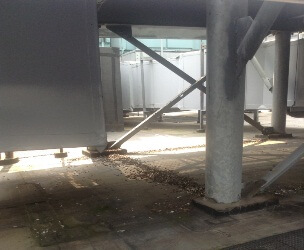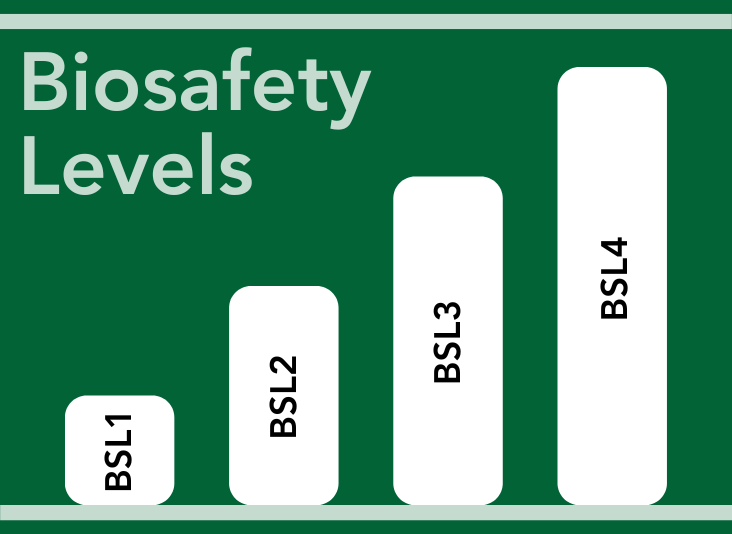The EH&S Implications of Pigeon Guano
Imagine pigeons roosting under the air intake vents on the cooling units of your buildings. Or guano accumulating by a roof drain, dismissed for months as a minor inconvenience. Situations like these pose real threats to facility aesthetics at a minimum, but more importantly, they impact the property’s integrity, employee's health, and an institution’s overall reputation. While the presence of guano may not feel like an immediate concern, the issue has monetary and health consequences. If you have a guano buildup at your facility, you should deal with upfront, in a proactive manner.
presence of guano may not feel like an immediate concern, the issue has monetary and health consequences. If you have a guano buildup at your facility, you should deal with upfront, in a proactive manner.
1. Guano is an eyesore
For institutions aspiring to become leaders in their field, visual presentation plays an enormously important role. Whether “presenting” to prospective students, business partners, or tenants, cleanliness and tidiness can go a long way towards making a good impression; the last thing anyone wants to see is an eyesore such as pigeon guano in the middle of a campus. And considering the resources routinely dedicated to maintaining a facility's landscape, cleaning up pigeon guano promptly should be an easy decision for any institution. If you need support from leadership, explain that avoiding guano decontamination can negatively affect your property value and hurt your corporate image. If your company owns the space that you reside in, you could have problems with leasing space in the future.
2. Guano can cause property damage
Bird droppings contain uric acid, which will eat through building materials, such as a waterproof roofing membrane, when the acid has a pH of 3 to 4.5. It can also corrode paint, fabrics, steel, brick, concrete, and stain surfaces if left unattended. If your building has a guano problem, deal with it now; you avoid long-term accumulation, which puts you at risk for more extensive damage and higher costs for decontamination and restoration services. Companies have spent millions of dollars on replacing machinery, roofs, and ventilation systems as a result of guano decontamination. Guano can also clog roof drains and gutters, causing roofs to flood during heavy rains. If birds or rodents make their way into your facility and nest in your warehouse, guano can become an indoor issue, too, with packaged or stored goods suffering integrity loss. Make sure to schedule routine inspections of your facility, whether these assessments are performed by one of your own personnel or by a health and safety vendor with expertise in facility care and guano decontamination. You might also consider, if you haven’t already, installing anti-perching products on your roof to avoid pigeon problems in the future.
3. Guano can pose a dangerous health hazard
Guano doesn’t just threaten your property's image, your building materials, and your inventory. It also puts your employees and any other occupants at risk. The longer guano is allowed to remain in place, the more likely harmful contaminants are to accumulate in that area. There are a number of contaminants that grow in high-nitrogen materials like guano, but the most common is a fungus called histoplasma capsulatum, which can affect the respiratory system once inhaled. Any individual exposed to these spores is at risk for contracting a dangerous lung infection, even if it is a one-time exposure. Think about that hypothetical situation from earlier, where pigeons nest under your air intake vents. Fungal spores exude from the pigeon waste, entering your building through air vents. When this guano accumulation is large-scale, these fumes put your building’s inhabitants at risk for histoplasma and other diseases like cryptococcosis, pseudotuberculosis, and Newcastle disease. When pigeons nest indoors in your warehouse, the risk of fumes is still present, as well as fleas who can transfer health problems from the guano itself to your workers. Protect your employees’ health and minimize your liability by performing guano decontamination or subcontracting out a vendor if you do not have the experience on-staff.
How-To Decontaminate Guano
If the accumulation is small, and just from a few birds, your own facilities personnel may be able to accomplish clean-up with basic protective equipment and disinfectants like soap and water. However, large scale guano decontamination should be carefully planned from start to finish before the work begins. Proper preparation for a job includes writing a health and safety plan (HASP), specifying the appropriate personal protection equipment (PPE), and detailing a procedure for the collection, drumming, and disposal of all contaminated materials. It is important to seal your heating and cooling air ducts in advance, and to wear a respirator that can filter particles as small as 0.3 microns. Given the work requirements and the associated health hazards, this is not a job for the new guy on staff. Rather, it should be performed by dedicated experts who complete the work both safely and thoroughly, leaving institutions with a clean appearance and a healthy, safe building environment. A professional vendor will know how to carry out the process safely and compliantly - wearing proper PPE, and correctly disposing of the waste for you.

Pigeon guano may be a problem that your facility currently treats as out-of sight, out-of-mind; however, if guano accumulation becomes substantial, it can cause significant physical problems for your facility, and harm the organization's image. More importantly, though, it puts employee and tenant health at risk. Advocate for decontamination and continuous monitoring to facility leadership at your organization, and mitigate this environmental, health, and safety risk.
Guano isn't the only problem that can be solved with routine inspection and maintenance. Discover 5 pieces of equipment throughout a facility that should be inspected on a routine basis in order to ensure safety and regulatory compliance, while also preventing costly equipment malfunction and emergency responses.






